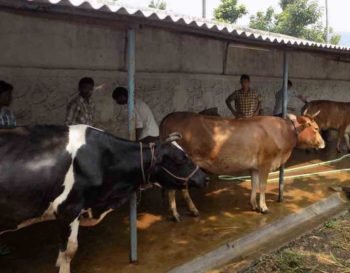Project report 2 cows
crossbred cow dairy project, Indigenous cow dairy farm
Dairy farming is a profitable business. It provides an excellent opportunity for self-employment for unemployed youth. It is also an important source of income generation to small/marginal farmers and agricultural laborers. India is the largest milk producer in the world. The demand for milk & milk product is increasing rapidly There is an immense scope of dairy farming in our country. The increasing cost of feed ingredients and its seasonal variability can be reduced by undertaking fodder cultivation.
Before starting a dairy farm the entrepreneurs/ farmers are advised to undergo training on dairy farming. They can contact Local Animal Husbandry Department staffs/Veterinary College/agriculture University etc. for the purpose. They should also visit progressive dairy farmers and government/ agricultural university dairy farms in the locality. They must check the following points before starting a dairy farm.
- Availability of good quality dairy breed cows in the nearby livestock market
- Nearness of the Farm to Veterinary Hospital, Artificial Insemination Center/livestock Aid Centers, MPCS
- Marketing facility of milk and milk product in the locality4.Availability of concentrates ,fodder & medicine in that locality.
This project report is based on the following assumption: 1. Freshly calved indigenous dairy breed/crossbred cows like RedSindhi/ Sahiwal/ Gir/ Rathi/ Crossbred cows in 1st or 2nd lactation will be purchased in two batches of two animals each at an interval of 5 to 6 months.2. Availability of 0.5 acres of irrigated land is prerequisite for the project3. Cost of labour has not been taken into consideration since full-time labour is not required for the small unit. Family labour will be utilized for maintenance of the dairy farm.4.Fodder cultivation considered in 0.5 acre land, Two crops considered per year.5. Cow dung produced will be utilized as Manure for fodder cultivation.6.Cost of rearing calves is not considered as it will be nullified by their sale value7.In case of death cow new cow will be purchased from insurance claim money8.The scheme is workable on the above guidelines if run by the dairy farmer on scientific lines.
Housing for cows –Floor –Pucca, smooth strong concrete cemented, impervious to moisture ,and have slope 1 in 60 towards gutter. Plinth should be 2ft. higher than ground.Walls-3ft. high lengthwise brick wall on sides, End wall should be solid made of bricks.Roof– 14-16ft. high at the center and 8 ft. high on the side wall .there should be hang over 3ft beyond wall to prevent rain water from entering cow shade. Roof should be of asbestos, cement asbestos, or tile. thatched roof can replace asbestos in low cost housing.
| ITEMS | LENGTH IN METER |
| MANGER | 0.6M |
| STANDING PLACE | 1.5M |
| GUTTER | 0.4M |
| FEEDING PASSAGE | 1.2M |
| MILKING PLACE | 1.2M |
| . Techno economic parameter | |
| Type of Animal | Indigenous Milch breed crossbred/ CB Jersey Cow |
| No. of Animals | 2 |
| Cost of Animal (Rs./animal) | 35000/cow |
| Average Milk Yield (litre/day) | 10 |
| Floor space (sqft) per adult animal | 40 |
| Floor space (sqft) per calf | 20 |
| Cost of construction per sqft (Rs.) | 300 |
| Cost of equipment per animal (Rs.) | 1000 |
| Cost of fodder cultivation (Rs./acre/season) | 6000 |
| Insurance premium (% per annum) | 5 |
| Veterinary aid/animal/ year (Rs.) | 2000 |
| Cost of concentrate feed (Rs./kg) | 20 |
| Cost of dry fodder (Rs./kg) | 4 |
| Rate of interest (%) | 12 |
| Repayment period (years) | 6 |
| Selling price of milk (Rs./kg) | 32 |
| Sale price of gunny bags (Rs. per bag) | 10 |
| Lactation days | 280 |
| Dry days | 150 |
Feeding requirement and expenditure is given in Feed chart for cow
| Lactation chart/Dry chart | |||||||
| Sr.No | Particulars | Years | |||||
| I | II | III | IV | V | Vi | ||
| i) | Lactation Days | ||||||
| a) | First batch | 250 | 280 | 250 | 210 | 210 | 250 |
| b) | Second batch | 180 | 210 | 210 | 210 | 210 | 210 |
| Total | 430 | 490 | 460 | 420 | 420 | 460 | |
| ii) | Dry Days | ||||||
| a) | First batch | 110 | 80 | 110 | 150 | 150 | 110 |
| b) | Second batch | – | 150 | 150 | 150 | 150 | 150 |
| Total | 110 | 230 | 260 | 300 | 300 | 260 | |

